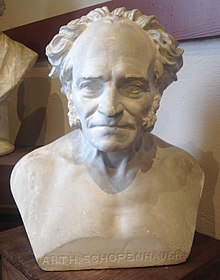
Christian Daniel Rauch was a German sculptor. He founded the Berlin school of sculpture, and was the foremost German sculptor of the 19th century.
Events from the year 1859 in art.
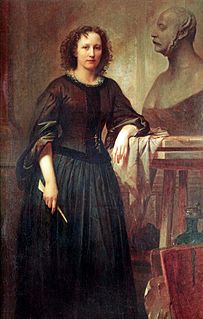
Franzisca Bernadina Wilhelmina Elisabeth Ney was a celebrated German-American sculptor who spent the first half of her life and career in Europe, producing portraits of famous leaders such as Otto von Bismarck, Giuseppe Garibaldi and King George V of Hanover. At age 39, she immigrated to Texas with her husband, Edmund Montgomery, and became a pioneer in the development of art there. Among her most famous works during her Texas period were life-size marble figures of Sam Houston and Stephen F. Austin, commissions for the Texas State Capitol. A large group of her works are housed in the Elisabet Ney Museum, located in her home and studio in Austin. Other works can be found in the US Capitol, the Smithsonian American Art Museum, and numerous collections in Germany.
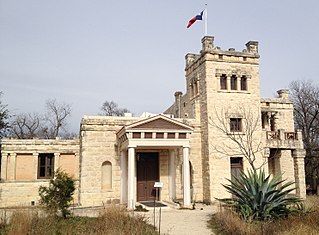
The Elisabet Ney Museum is a museum located in Austin, Texas, United States. It is housed in the former studio of sculptor Elisabet Ney and is dedicated to showcasing her life and works. There is a permanent collection of her portrait busts and personal memorabilia on display.

Edmund Duncan Montgomery was a Scottish-American philosopher, scientist and physician. He was the husband of German-American sculptor Elisabet Ney

Artus Quellinus also known as Artus (Arnoldus) Quellijn, Artus Quellinus I or Artus Quellinus the Elder was a Flemish sculptor. He is regarded as the most important representative of the Baroque in sculpture in the Southern Netherlands. His work had a major influence on the development of sculpture in Northern Europe.
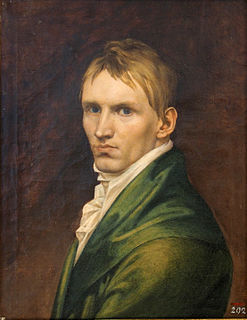
Christian Friedrich Tieck, often known only as Friedrich Tieck, was a German sculptor and a occasional artist in oils. His work was primarily figurative and includes both public statuary and private commissions for portrait busts.

Adolf Brütt was a German sculptor. He was the founder of the Weimarer Bildhauerschule and its accompanying bronze foundry.

Luise Adelaide Lavinia Schopenhauer, known as Adele Schopenhauer, was a German author. She was the sister of the philosopher Arthur Schopenhauer and daughter of author Johanna Schopenhauer. Henriette Sommer and Adrian van der Venne were pseudonyms used by her.

Stephen F. Austin is a statue of Stephen F. Austin by Elisabet Ney, originally modeled in 1893 and installed in 1905, which is part of the National Statuary Hall Collection in the United States Capitol in Washington, D.C., as one of the two statues from Texas; the other Texas statue, Sam Houston, is also by Ney and was produced in parallel. Another carving of Stephen F. Austin is displayed in the Texas State Capitol, where it was installed in 1903.
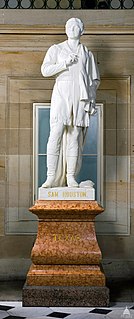
Sam Houston is a statue of Sam Houston by Elisabet Ney, originally modeled in 1892 and installed in 1905, which is part of the National Statuary Hall Collection in the United States Capitol in Washington, D.C., as one of the two statues from Texas; the other Texas statue, Stephen F. Austin, is also by Ney and was produced in parallel. Another carving of Sam Houston is displayed in the Texas State Capitol, where it was installed in 1903.

Lady Macbeth is a statue of the Shakespearean character Lady Macbeth by German American sculptor Elisabet Ney. The sculpture is a life-size full-length female figure rendered in marble. Completed in 1905, Lady Macbeth is one of Ney's last works and was regarded by the artist as her masterpiece. It is housed in Washington, D.C. in the Luce Foundation Center for American Art at the Smithsonian American Art Museum, which acquired the piece in 1998.

Albert Sidney Johnston is a memorial statue of General Albert Sidney Johnston by German American sculptor Elisabet Ney. The piece is a life-size recumbent male figure rendered in marble sculpture. It depicts the General at the time of his death in the Battle of Shiloh during the American Civil War. Completed in 1903, the piece resides atop Johnston's tomb in the Texas State Cemetery in Austin, Texas, where it was installed in 1905.

Jacob Grimm is a sculpture of German philologist Jacob Grimm by sculptor Elisabet Ney. Completed in 1858, the piece is a portrait bust rendered in marble. The bust was modeled and carved in Berlin, but it is now held by the Elisabet Ney Museum in Austin, Texas.

Eilhard Mitscherlich is a sculpture of German chemist Eilhard Mitscherlich by sculptor Elisabet Ney. Completed in 1863, the piece is a portrait bust rendered in marble. The marble bust is now held by the Berlin's Natural History Museum, while the original plaster is displayed in Mitscherlich's mausoleum in Berlin's Alter St.-Matthäus-Kirchhof.
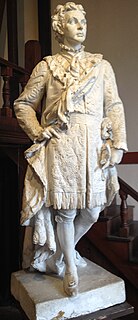
Ludwig II is a sculpture of King Ludwig II of Bavaria by sculptor Elisabet Ney. Completed in 1870, the piece is a portrait statue rendered in plaster. The statue was modeled and carved in Germany, but it is now held by the Elisabet Ney Museum in Austin, Texas; a marble version, completed by another sculptor, is installed in the Herrenchiemsee Palace in Bavaria.

Giuseppe Garibaldi is a sculpture of Italian revolutionary Giuseppe Garibaldi by German sculptor Elisabet Ney. Completed in 1866, the piece is a portrait bust rendered in marble. The portrait was modeled and carved in Italy, but it is now held by the Elisabet Ney Museum in Austin, Texas.
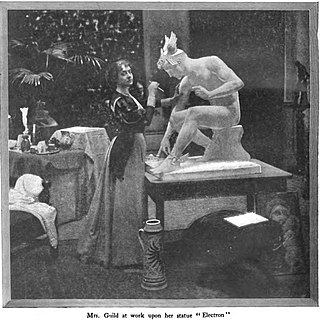
Emma Marie Cadwalader-Guild, also known by Cadwallader-Guild, was an American artist, notable for her sculpture busts of significant figures. Her subjects included President William McKinley, Andrew Carnegie, and George Frederick Watts, among others. Cadwalader-Guild spent much of her career abroad and achieved particular notoriety in England and Germany.

Ambrosia Tønnesen was a Norwegian sculptor. She is regarded as the first professional female sculptor in Norway, and is best known for her many portraits, including statues, busts, and reliefs.
